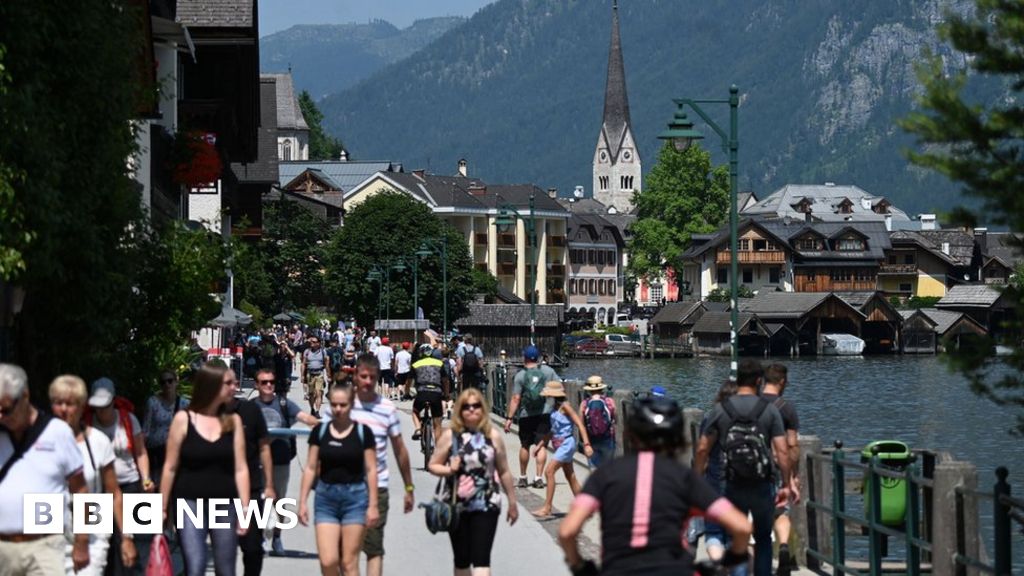Global Tourism Sector Report 2025: Navigating Challenges Through the Lens of Sustainable Development Goals
Addressing Overtourism to Foster Sustainable Cities and Communities (SDG 11) and Decent Work and Economic Growth (SDG 8)
The global tourism industry in 2025 faces a critical challenge in balancing economic growth with urban and environmental sustainability. The phenomenon of overtourism is compelling destinations to implement regulations that align with SDG 11 (Sustainable Cities and Communities) and SDG 8 (Decent Work and Economic Growth). These measures aim to protect cultural and natural heritage while ensuring the long-term viability of tourism economies.
- Regulatory Leadership: European cities such as Venice, Amsterdam, and Paris are pioneering efforts to manage tourist influx.
- Global Adoption: Other nations are following suit with specific control measures.
- Mexico: Introduction of cruise ship restrictions.
- Peru: Strict visitor limits at Machu Picchu.
- Japan: Imposition of visitor limits in historic districts of Kyoto.
- Economic Instruments for Sustainability: A growing number of cities are using tourist taxes to fund local infrastructure and environmental projects, directly supporting the principles of SDG 11.
- Barcelona: Increased tourist tax, with a target of €8 by 2029.
- Other Cities: Rome, Paris, New York, and Montreal are adjusting taxes to mitigate the environmental impact of tourism.
Climate Action (SDG 13) as an Imperative for Tourism Resilience
The escalating impacts of climate change present a direct threat to the tourism sector, underscoring the urgency of SDG 13 (Climate Action). Extreme weather events are causing significant operational disruptions and influencing travel patterns globally.
- Aviation Disruptions: Severe weather, including thunderstorms and flash floods, has severely impacted the U.S. aviation sector.
- Over 250 flights were grounded at major hubs like Chicago O’Hare, JFK, and LaGuardia.
- Airlines including Southwest, Delta, United, and JetBlue have experienced significant delays and cancellations.
- Extreme Heat and Public Health (SDG 3): A dangerous heatwave across the U.S. Gulf Coast and southeastern cities is affecting tourism and public well-being.
- Heat advisories are in effect in Atlanta, New York, and Boston.
- Health warnings have led to the cancellation of outdoor events and are forcing a reconsideration of summer travel plans.
Ensuring Peace, Justice, and Strong Institutions (SDG 16) for Traveler Safety
The security of travelers is paramount and directly linked to the stability and effectiveness of local institutions, a core tenet of SDG 16 (Peace, Justice and Strong Institutions). Safety concerns in certain regions highlight the challenges in maintaining the peaceful conditions necessary for a thriving tourism industry.
- Travel Advisories: The U.S. State Department has issued a “Do Not Travel” advisory for Mexico’s Tamaulipas state due to cartel-related violence.
- Security Risks: Ongoing issues of kidnapping and extortion create a high-risk environment, deterring tourism despite increased local police presence.
- Impact on Regional Stability: Such security challenges serve as a critical reminder of the foundational importance of peace and justice for sustainable tourism development.
Shifting Toward Responsible Consumption and Production Patterns (SDG 12)
Evolving economic conditions and geopolitical factors are reshaping global travel flows, reflecting a shift in consumer behavior that aligns with SDG 12 (Responsible Consumption and Production). These changes are evident in both international arrival data and domestic travel preferences.
- Decline in Canadian Inbound Tourism: Canada has experienced a sharp drop in tourism from key markets, including the U.S., UK, France, Germany, and Australia, due to geopolitical tensions and changing travel habits.
- Rise of Domestic Tourism: In response to high travel costs and external political factors, Canadians are increasingly opting for domestic vacations. This trend toward local travel reduces the carbon footprint associated with long-haul flights.
- Growth of Budget Travel in the U.S.: While legacy carriers maintain a strong position, the market share of low-cost airlines like Allegiant, Sun Country, and Spirit is growing. This reflects a post-pandemic consumer focus on affordability, influencing production and service models within the airline industry.
The Way Forward: Integrating SDGs for a Resilient Tourism Future
The challenges of 2025 necessitate a fundamental adaptation within the global tourism industry. A resilient future for travel depends on the comprehensive integration of the Sustainable Development Goals. Key areas of focus must include:
- Sustainability: Balancing the economic benefits of tourism with the protection of local communities and ecosystems (SDG 8, SDG 11, SDG 12).
- Safety: Ensuring that destinations are safe and secure through effective governance and justice (SDG 16).
- Climate Adaptation: Building resilience to the unavoidable impacts of climate change and mitigating the industry’s environmental footprint (SDG 13).
Analysis of Sustainable Development Goals in the Article
1. Which SDGs are addressed or connected to the issues highlighted in the article?
-
SDG 8: Decent Work and Economic Growth
The article discusses the economic aspects of the tourism industry, including its growth, the challenges of overtourism, and the implementation of policies like tourist taxes to ensure its sustainability. It also touches upon economic downturns, such as Canada’s decline in inbound tourism, and shifts in consumer behavior towards budget travel, all of which relate to promoting sustained, inclusive, and sustainable economic growth.
-
SDG 11: Sustainable Cities and Communities
The central theme of overtourism directly relates to this goal. The article highlights how cities like Venice, Barcelona, and Kyoto are struggling to manage tourist flows to protect their infrastructure, cultural heritage, and the well-being of local communities. Measures such as visitor limits and tourist taxes are aimed at making these urban destinations more sustainable and resilient.
-
SDG 13: Climate Action
The article explicitly links climate change to significant disruptions in the travel industry. It details how severe weather events (thunderstorms, floods), dangerous heatwaves, and rising global temperatures are causing flight cancellations, health advisories, and forcing travelers to change their plans. This underscores the urgent need for climate adaptation and resilience within the tourism sector.
-
SDG 16: Peace, Justice and Strong Institutions
This goal is addressed in the section on safety and security. The “Do Not Travel” advisory issued by the U.S. State Department for Mexico’s Tamaulipas state due to “ongoing cartel violence, including kidnappings and extortion” highlights how the absence of peace and security directly impacts society and economic sectors like tourism.
2. What specific targets under those SDGs can be identified based on the article’s content?
-
Target 8.9: “By 2030, devise and implement policies to promote sustainable tourism that creates jobs and promotes local culture and products.”
The article describes numerous policies aimed at achieving sustainable tourism. Examples include Barcelona raising its tourist tax to fund sustainability initiatives, and destinations like Machu Picchu and Kyoto imposing “strict visitor limits” to “protect the environment and preserve cultural landmarks.” These are direct examples of policies being implemented to manage tourism sustainably.
-
Target 11.4: “Strengthen efforts to protect and safeguard the world’s cultural and natural heritage.”
The article’s discussion on overtourism focuses on the need to protect cultural heritage. It states that popular destinations are leading efforts to curb “negative effects on local communities and cultural heritage.” The implementation of visitor limits in “iconic locations such as Machu Picchu in Peru and the historic districts of Kyoto in Japan” is a direct action towards safeguarding this heritage.
-
Target 13.1: “Strengthen resilience and adaptive capacity to climate-related hazards and natural disasters in all countries.”
The article emphasizes the need for the tourism industry to adapt to climate change. It describes how “severe weather events are wreaking havoc on aviation schedules” and “extreme heat waves” are disrupting travel plans. The conclusion calls for “adaptation and resilience” and “climate adaptation” as key to the future of global travel, directly aligning with this target.
-
Target 16.1: “Significantly reduce all forms of violence and related death rates everywhere.”
The travel advisory for Tamaulipas due to “ongoing cartel violence, including kidnappings and extortion” directly reflects the presence of violence that this target aims to reduce. The advisory itself is a response to the failure to ensure safety and security in the region, making the issue relevant to this target.
3. Are there any indicators mentioned or implied in the article that can be used to measure progress towards the identified targets?
-
For Targets 8.9 and 11.4:
- Implementation of tourism regulations: The article mentions specific regulations like “cruise restrictions in Hawaii” and “strict visitor limits” in Machu Picchu and Kyoto. The number and scope of such policies can be an indicator.
- Tourist tax levels: The article provides a quantifiable indicator with “Barcelona… raised its tourist tax, with plans to increase it to €8 by 2029.” Tracking the value and use of such taxes measures progress.
- Tourist arrival data: The mention of “Canada’s inbound tourism has dropped sharply” implies that changes in tourist numbers can be used as an indicator to assess the impact of various factors, including sustainability policies or their absence.
-
For Target 13.1:
- Number of weather-related disruptions: The article quantifies this by stating that “more than 250 flights” were grounded due to severe weather. This number serves as a direct indicator of the impact of climate hazards on infrastructure.
- Issuance of health and weather advisories: The mention of cities like Atlanta, New York, and Boston being “under heat advisories” is an indicator of the frequency and severity of climate-related health risks.
-
For Target 16.1:
- Government travel advisories: The issuance of a “‘Do Not Travel’ advisory” by the U.S. State Department is a clear, official indicator of high levels of violence and risk in a specific region.
4. SDGs, Targets and Indicators Table
| SDGs | Targets | Indicators |
|---|---|---|
| SDG 8: Decent Work and Economic Growth | 8.9: Devise and implement policies to promote sustainable tourism. |
|
| SDG 11: Sustainable Cities and Communities | 11.4: Strengthen efforts to protect and safeguard the world’s cultural and natural heritage. |
|
| SDG 13: Climate Action | 13.1: Strengthen resilience and adaptive capacity to climate-related hazards. |
|
| SDG 16: Peace, Justice and Strong Institutions | 16.1: Significantly reduce all forms of violence and related death rates everywhere. |
|
Source: travelandtourworld.com






